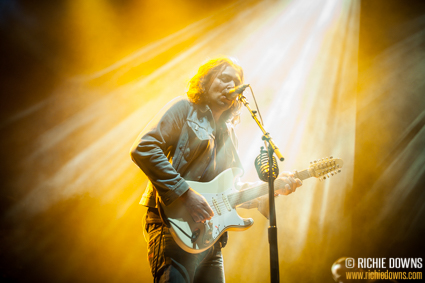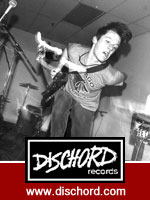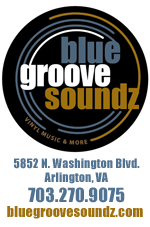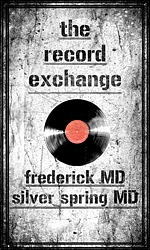
Ex Hex performing at Landmark Festival 2015. 09/26/2015. Photo Credit: Clarissa Villondo www.clarissavillondo.com
PHOTOS: RICHIE DOWNS & CLARISSA VILLONDO | Since the days of Woodstock, the big destination rock festivals for years only occurred in England, Europe, and other exotic places. In the past decade or two, though, there has been a concentrated effort to create big annual music festivals tied to specific U.S. locales: Bonnaroo in Tennessee, Coachella in California, the Austin City Limits in Texas, the Lollapallooza setting shop in Chicago. New Orleans and Newport kept their distinction with their particular styles of music. Now every city seems to have its own fest, from Philly’s Made in America to Atlanta’s Shaky Knees and Dover’s Firefly.
And now so does D.C.
The first Landmark Music Festival occurred the last weekend in September while another music festival was going on in New York, the Global Citizen thing with Beyonce and Pearl Jam. Compared to that, the Landmark wasn’t a landmark at all; it was scarcely a blip. Its headliners were Drake and The Strokes and having spent most of their money on those, they apparently didn’t have a big pile of money left for the rest of the dozens of acts.

Either that, or I have much less tolerance for mediocrity than I once had, especially when you have to walk a quarter-mile back and forth between stages desperate to see something, anything good to hear (it’s not like turning the channel, believe me). Landmark, brought to you by the people who brought you Lollapallooza and other big annual fests, did seem to be very well-organized from past experiences elsewhere. So in addition to recordings repeating what to do and where to go at the gate, there were people with loudspeakers greeting you before they repeated where to go at what to do at the gate.
Because Landmark was in the fenced off baseball fields between the Martin Luther King memorial and the Potomac, and if you didn’t see the Washington Monument poking up from the horizon you’d hardly know you were in D.C. at all (except for the planes coming in to National all day). You could go and sit by the Potomac for a while if you wanted, but to do so you had to go around the line of Port-o-pottys. To lessen the sinking feeling of being in a compound, they put a series of flags along the perimeter to feign festive-ness.
The stages were named after presidents: Roosevelt, Jefferson, Lincoln, Miller Lite, BMI. (That’s a joke. But actually, there would have been one more corporate-named stage. However, circumstances last week made them rename the Volkswagen stage to Lincoln at the last moment. And that is not a joke.)



It was cool to have some of the best city restaurants represented at the food court, giving visitors a true taste of the city, though offerings like the $10 shrimp burger from Proof. Too bad that theme didn’t carry through to the beverages. There could have been a bunch of cool DC microbrews, but instead they offered Miller Lite and Coors tallboys, two kinds of alcoholic cider and Blue Moon, a roster that seemed more a reflection of sponsors than public demand. (Though there were more people drinking cider than I would ever imagine; the same way there were people who seemed to like this music more than I could ever imagine. Maybe they were just loopy on cider).
But beer is beer and the most alarming sight Saturday night were lines that were literally more than 100 people long with waits of more than an hour. For Miller Lite. So when people got to the front they often bought six tallboys at a time. The resulting lines at the Port-o-potties I don’t even want to imagine. But that’s first world festival problems—if you don’t want to go stand in line for Port-o-potties, don’t stand in line for beer. It’s what you usually have to do on the mall anyway.
There were mixed drinks available, but only in the VIP areas, which were weird, high-priced compounds on the edges of the stage, but pretty far back. So they could be elevated to show their imagined superiority over others. The VIP pass also allowed them to step in front of the security fences so they could enjoy music apart from the great unwashed and rub shoulders with actual photographers. I think they had access to better bathrooms, but at least they were not carried on litters from stage to stage.
If it had rained substantially, it would have combined for a certain kind of hell. Instead, it was just cloudy all weekend (something all the people in sunglasses didn’t seem to grasp).



The best reflection of D.C. could have come on the stages, of couse. Instead, they only featured a few token D.C. acts. Ex Hex was great and the only reason to come early as I did on Saturday. They were also one of the few acts I watched from start to finish. But where were the other D.C. rock bands?
Of local rappers, Wale was a big late afternoon highlight Saturday and the much lesser Ace Cosgrove was there Sunday. There were four outdoor stages and a big outdoor tent, why not dedicate one to local heroes? How about something to give out of towners a taste of what D.C. has to offer and has built its scene on? A dedicated go-go tent, if not a Dischord heritage stage? One for Babe City would have been fine.
That might have aided what turned out to be wildly random if not festival-generic programming for both days. Good festivals should have an angle or at least a number of acts of a certain slice of music to justify buying an all day (or all weekend) pass. D.C. could tilt any number of ways based on its heritage, from soul and go-go to rap to country-bluegrass, punk or Americana. Any direction would be preferable to the mishmash that fit under the category: Anybody who happened to be available.
The off-putting of one act made you walk to the other side of the festival for something else, only to double back again. You’d think the theme of the fest was fitness rather than raising money for the National Mall. But maybe they wanted to keep people in motion, so as to sample the various sponsor booths in between. The largely younger audience seemed only to happy to brand themselves in corporate giveaways, be they garish sunglasses, bandanas, or State Farm backpacks.



Back when Live Nation was still Clear Channel, a radio conglomerate, its big idea was to organize big live music events as if they were actually radios: Lure kids in with their music and then walk them through the ads: branding everything in sight to maximize promotion opportunities. It’s especially true at festivals now, where corporate targeting fuels every crass giveaway. Smokey the Bear might shed a tear that the National Parks Service is so wrapped up in this, too. There was a booth where you might get a free trip to the park of your choice if you become a willing shill on your social media.
Another one sort of cynically promoted non-specific advocacy, giving out paint so you could write down what you’d march on the mall for. “Sex Drugs and Rock and Roll” said one, predictably, (perhaps referring instead to the FX comedy of the same name). “Puppies” wrote another. Someone wrote “No Guns” but then someone else crossed out the “no.” So: there’s your deadlock. You could charge your phone as a DJ played but you had to sign up for it (so salesmen will call).
Less marketing (and fewer people in general) were found in a specially cordoned off kids area, where the various booths included “Punk Rock Hairdos;” what was once called face painting now called “Tattoos;” and a “Musical Petting Zoo” where a kid could hold an actual electric guitar (in their day-glo punk hair and “tattoo”). Wisely, little kids seemed scarce at the entire event.
Landmark tried to be a modern festival, offering wristbands that could pay for food and drink with its barcode; schedules via phone. But a scheme that gave out T-shirts to those who collected empty beer cans in plastic bags seemed to take advantage of festivalgoers of good will.




I’m out of it in the world of festivals, where women wear extra skimpy clothes for the occasion and where there was a guy who brought in a hula hoop with which to contort and perform. (Who let him in with a hula hoop?). When I saw a second person with a hula hoop, I began to think that these were plants, hired from Cirque de Soliel unemployment lines to add a false festiveness to the event. I guess it was better than the tambourines similar people brought to earlier festivals; at least hula hoopers didn’t make extraneous noise.
There were some musical performances I glad I saw, though. In addition to Ex Hex, I’d say the British trio Daughter was beguiling on a big stage, with front woman Elena Tonra showing her shyness on the huge video screens flanking the trio. Albert Hammond Jr. had a good set of power pop before he would return the next day to join the headlining Strokes. It was good, too, to see Rebirth Brass Band on the roster as lone example of New Orleans flavor of the day.
Sunday highlights included Rhiannon Giddens, blending her grasp of gospel and history with a solid band and a stellar voice. Another standout was a set by Hiss Royal Majesty, doing honest rock that spun out and boogied from the confines his last record. And there was also the great Dr. John in a fine performance. He was one of the only representatives of real architects of American popular music booked to play though they could have gotten any number from old blues and R&B to rock-n-roll. Chuck Berry on the National Mall, that’s what I want to see.
Throughout, there seemed none of the surprise on-stage collaborations that make festivals special: So many artists booked, so many possibilities. Most bands played their 45 minutes and booked.

The one surprise—a band I didn’t know that made an impression—was The Suffers, as strong an R&B outfit from Texas as Sharon Jones is from the Northeast. And lead singer Kam Franklin had the kind of vamping style of another classic soul figure from Houston, Archie Bell.
But there was an awful lot of padding in between. And if you want to make your mark as a music festival, you want to do it with a style, with a statement, not with stuffing.
PHOTOS by RICHIE DOWNS:
EX HEX


TWIN SHADOW







U.S. ROYALTY









DAUGHTER









EMPRESARIOS


BEN HOWARD









MIGUEL







THE LONDON SOULS


THE WAR ON DRUGS









WALE












PHOTOS by CLARISSA VILLONDO:
EX HEX

Ex Hex performing at Landmark Festival 2015. 09/26/2015. Photo Credit: Clarissa Villondo www.clarissavillondo.com

Ex Hex performing at Landmark Festival 2015. 09/26/2015. Photo Credit: Clarissa Villondo www.clarissavillondo.com

Ex Hex performing at Landmark Festival 2015. 09/26/2015. Photo Credit: Clarissa Villondo www.clarissavillondo.com

Ex Hex performing at Landmark Festival 2015. 09/26/2015. Photo Credit: Clarissa Villondo www.clarissavillondo.com

Ex Hex performing at Landmark Festival 2015. 09/26/2015. Photo Credit: Clarissa Villondo www.clarissavillondo.com

Ex Hex performing at Landmark Festival 2015. 09/26/2015. Photo Credit: Clarissa Villondo www.clarissavillondo.com
U.S. ROYALTY

US Royalty at Landmark Festival 2015. 09/26/15. Photo Credit: Clarissa Villondo www.clarissavillondo.com

US Royalty at Landmark Festival 2015. 09/26/15. Photo Credit: Clarissa Villondo www.clarissavillondo.com

US Royalty at Landmark Festival 2015. 09/26/15. Photo Credit: Clarissa Villondo www.clarissavillondo.com

US Royalty at Landmark Festival 2015. 09/26/15. Photo Credit: Clarissa Villondo www.clarissavillondo.com

US Royalty at Landmark Festival 2015. 09/26/15. Photo Credit: Clarissa Villondo www.clarissavillondo.com

US Royalty at Landmark Festival 2015. 09/26/15. Photo Credit: Clarissa Villondo www.clarissavillondo.com

US Royalty at Landmark Festival 2015. 09/26/15. Photo Credit: Clarissa Villondo www.clarissavillondo.com

US Royalty at Landmark Festival 2015. 09/26/15. Photo Credit: Clarissa Villondo www.clarissavillondo.com
THE MOWGLIS

The Mowgli’s at Landmark Festival 2015. 09/26/15. Photo Credit: Clarissa Villondo www.clarissavillondo.com

The Mowgli’s at Landmark Festival 2015. 09/26/15. Photo Credit: Clarissa Villondo www.clarissavillondo.com

The Mowgli’s at Landmark Festival 2015. 09/26/15. Photo Credit: Clarissa Villondo www.clarissavillondo.com

The Mowgli’s at Landmark Festival 2015. 09/26/15. Photo Credit: Clarissa Villondo www.clarissavillondo.com

The Mowgli’s at Landmark Festival 2015. 09/26/15. Photo Credit: Clarissa Villondo www.clarissavillondo.com
THE LONDON SOULS

The London Souls at Landmark Festival 2015. 09/26/15. Photo Credit: Clarissa Villondo www.clarissavillondo.com

The London Souls at Landmark Festival 2015. 09/26/15. Photo Credit: Clarissa Villondo www.clarissavillondo.com

The London Souls at Landmark Festival 2015. 09/26/15. Photo Credit: Clarissa Villondo www.clarissavillondo.com
BEN HOWARD

Ben Howard at Landmark Festival 2015. 09/26/15. Photo Credit: Clarissa Villondo www.clarissavillondo.com

Ben Howard at Landmark Festival 2015. 09/26/15. Photo Credit: Clarissa Villondo www.clarissavillondo.com

Ben Howard at Landmark Festival 2015. 09/26/15. Photo Credit: Clarissa Villondo www.clarissavillondo.com

Ben Howard at Landmark Festival 2015. 09/26/15. Photo Credit: Clarissa Villondo www.clarissavillondo.com

Ben Howard at Landmark Festival 2015. 09/26/15. Photo Credit: Clarissa Villondo www.clarissavillondo.com

Ben Howard at Landmark Festival 2015. 09/26/15. Photo Credit: Clarissa Villondo www.clarissavillondo.com
ALBERT HAMMOND, JR.

Albert Hammond Jr. at Landmark Festival 2015. 09/26/15. Photo Credit: Clarissa Villondo www.clarissavillondo.com

Albert Hammond Jr. at Landmark Festival 2015. 09/26/15. Photo Credit: Clarissa Villondo www.clarissavillondo.com

Albert Hammond Jr. at Landmark Festival 2015. 09/26/15. Photo Credit: Clarissa Villondo www.clarissavillondo.com

Albert Hammond Jr. at Landmark Festival 2015. 09/26/15. Photo Credit: Clarissa Villondo www.clarissavillondo.com

Albert Hammond Jr. at Landmark Festival 2015. 09/26/15. Photo Credit: Clarissa Villondo www.clarissavillondo.com

Albert Hammond Jr. at Landmark Festival 2015. 09/26/15. Photo Credit: Clarissa Villondo www.clarissavillondo.com

Albert Hammond Jr. at Landmark Festival 2015. 09/26/15. Photo Credit: Clarissa Villondo www.clarissavillondo.com

Albert Hammond Jr. at Landmark Festival 2015. 09/26/15. Photo Credit: Clarissa Villondo www.clarissavillondo.com
VANDAVEER

Vandaveer at Landmark Festival 2015. 09/26/15. Photo Credit: Clarissa Villondo www.clarissavillondo.com

Vandaveer at Landmark Festival 2015. 09/26/15. Photo Credit: Clarissa Villondo www.clarissavillondo.com

Vandaveer at Landmark Festival 2015. 09/26/15. Photo Credit: Clarissa Villondo www.clarissavillondo.com

Vandaveer at Landmark Festival 2015. 09/26/15. Photo Credit: Clarissa Villondo www.clarissavillondo.com

Vandaveer at Landmark Festival 2015. 09/26/15. Photo Credit: Clarissa Villondo www.clarissavillondo.com

Vandaveer at Landmark Festival 2015. 09/26/15. Photo Credit: Clarissa Villondo www.clarissavillondo.com
THE WAR ON DRUGS

The War on Drugs at Landmark Festival 2015. 09/26/15. Photo Credit: Clarissa Villondo www.clarissavillondo.com

The War on Drugs at Landmark Festival 2015. 09/26/15. Photo Credit: Clarissa Villondo www.clarissavillondo.com

The War on Drugs at Landmark Festival 2015. 09/26/15. Photo Credit: Clarissa Villondo www.clarissavillondo.com

The War on Drugs at Landmark Festival 2015. 09/26/15. Photo Credit: Clarissa Villondo www.clarissavillondo.com

The War on Drugs at Landmark Festival 2015. 09/26/15. Photo Credit: Clarissa Villondo www.clarissavillondo.com

The War on Drugs at Landmark Festival 2015. 09/26/15. Photo Credit: Clarissa Villondo www.clarissavillondo.com

The War on Drugs at Landmark Festival 2015. 09/26/15. Photo Credit: Clarissa Villondo www.clarissavillondo.com
WALE

Wale at Landmark Festival 2015. 09/26/15. Photo Credit: Clarissa Villondo www.clarissavillondo.com

Wale at Landmark Festival 2015. 09/26/15. Photo Credit: Clarissa Villondo www.clarissavillondo.com

Wale at Landmark Festival 2015. 09/26/15. Photo Credit: Clarissa Villondo www.clarissavillondo.com

Wale at Landmark Festival 2015. 09/26/15. Photo Credit: Clarissa Villondo www.clarissavillondo.com

Wale at Landmark Festival 2015. 09/26/15. Photo Credit: Clarissa Villondo www.clarissavillondo.com

Wale at Landmark Festival 2015. 09/26/15. Photo Credit: Clarissa Villondo www.clarissavillondo.com

Wale at Landmark Festival 2015. 09/26/15. Photo Credit: Clarissa Villondo www.clarissavillondo.com

Wale at Landmark Festival 2015. 09/26/15. Photo Credit: Clarissa Villondo www.clarissavillondo.com

Wale at Landmark Festival 2015. 09/26/15. Photo Credit: Clarissa Villondo www.clarissavillondo.com

Wale at Landmark Festival 2015. 09/26/15. Photo Credit: Clarissa Villondo www.clarissavillondo.com

Wale at Landmark Festival 2015. 09/26/15. Photo Credit: Clarissa Villondo www.clarissavillondo.com

Wale at Landmark Festival 2015. 09/26/15. Photo Credit: Clarissa Villondo www.clarissavillondo.com

Wale at Landmark Festival 2015. 09/26/15. Photo Credit: Clarissa Villondo www.clarissavillondo.com
NATE RUESS

Nate Ruess at Landmark Festival 2015. 09/26/15. Photo Credit: Clarissa Villondo www.clarissavillondo.com

Nate Ruess at Landmark Festival 2015. 09/26/15. Photo Credit: Clarissa Villondo www.clarissavillondo.com

Nate Ruess at Landmark Festival 2015. 09/26/15. Photo Credit: Clarissa Villondo www.clarissavillondo.com

Nate Ruess at Landmark Festival 2015. 09/26/15. Photo Credit: Clarissa Villondo www.clarissavillondo.com

Nate Ruess at Landmark Festival 2015. 09/26/15. Photo Credit: Clarissa Villondo www.clarissavillondo.com

Nate Ruess at Landmark Festival 2015. 09/26/15. Photo Credit: Clarissa Villondo www.clarissavillondo.com













